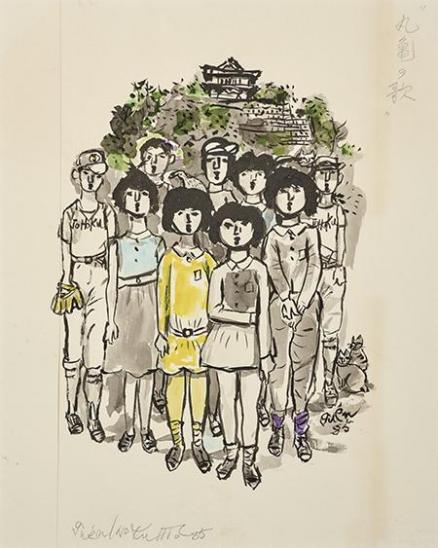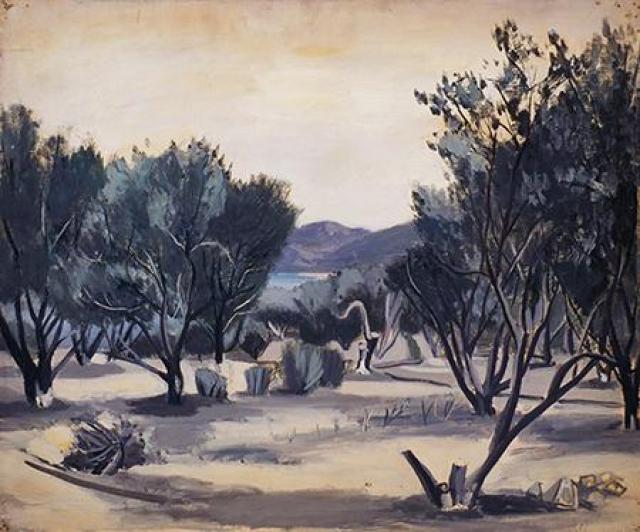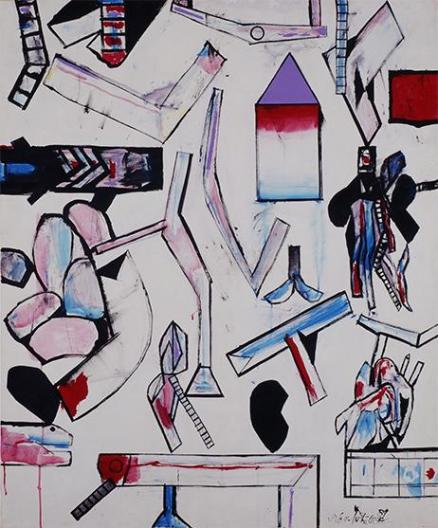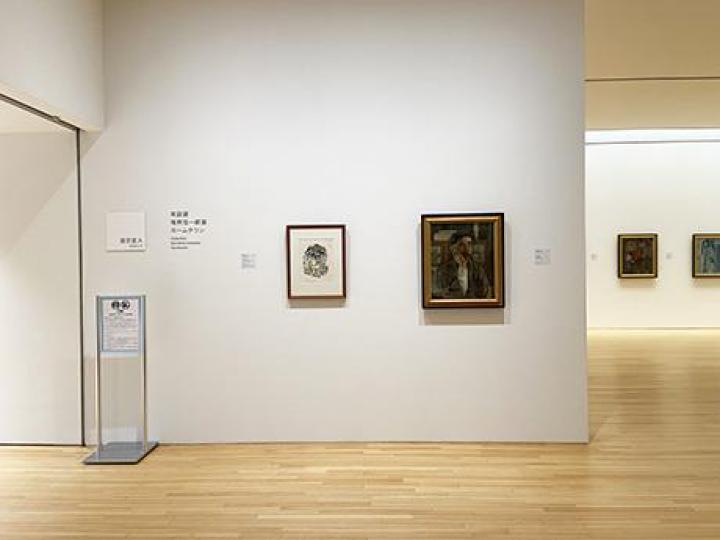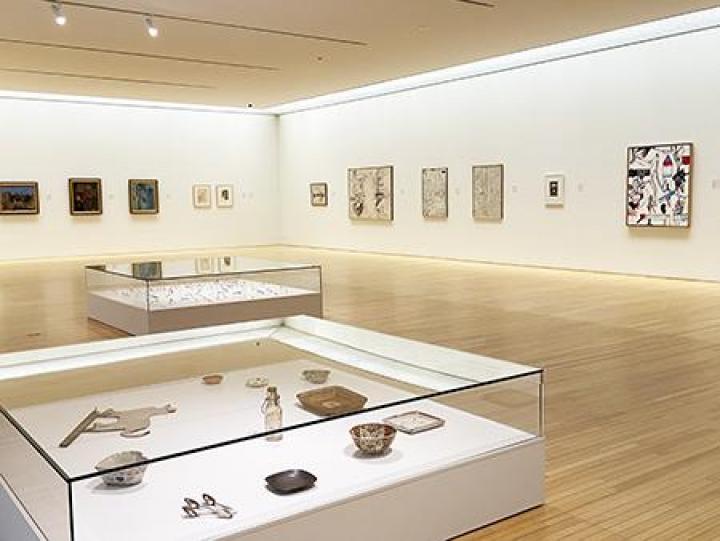1. Genichiro Inokuma, Songs of Marugame, 1985
2. Genichiro Inokuma, Mother's Figure, 1924
3. Genichiro Inokuma, Still Life in Atlier, ca. 1929
4. Genichiro Inokuma, Olives in Shodo-Shima, 1934
5. Genichiro Inokuma, Family in the Car, 1938
6. Genichiro Inokuma, Kabuki No.1, 1956
7. Genichiro Inokuma, Build a House, 1987
8. Genichiro Inokuma, Happy Family, 1989
9, 10. Gallery A
Genichiro Inokuma: Hometown Genichiro Inokuma: Hometown
Date: Sat. 12 October 2024 - Mon. 13 January 2025
Closed: Mondays (except 14 October, 4 November 2024, 13 January 2025), Tue. 15 October, Tue. 5 November, Wed. 25 - Tue. 31 December 2024
Hours: 10:00 - 18:00 (Admission until 30 minutes before closing time)
Organized by Marugame Genichiro-Inokuma Museum of Contemporary Art, The MIMOCA Foundation
Admission: Adults ¥300, Students (college, university) ¥200, Children (0 year to high school) free
*Free admission day: 23 November 2024
As a counterpart to the special exhibition “Home Sweet Home,” this exhibition explores the artworks of Genichiro Inokuma (1902-1993) seeking the meaning that “home” held for him.
[Kagawa-Tokyo]
Genichiro Inokuma was born and raised in Kagawa Prefecture. After graduating from middle school (secondary school under the old educational system), he moved to Tokyo and entered the Tokyo Fine Arts School. In his days as a student soon after leaving home, he sometimes drew pictures related to his hometown. After falling ill on the way home for his first summer vacation, Inokuma was forced to take a year off from school. Boy is a work inspired by a child on crutches he met on a Marugame island during his leave of absence. Landscape, Second Work and Late Summer are both depictions of sunflowers his father planted in the garden for him to enjoy while home during the summer of his third year of studies.
In Olives in Shodo-Shima, a work painted some ten years later, he freshly captures the familiar Seto Inland Sea as a new motif, inspired by the exotic atmosphere of olive trees, a rarity in Japan at the time.
[Paris-Tokyo]
On turning 35 in 1938, Inokuma fulfilled his long-cherished dream of studying in Paris. Settled in the land of his dreams, he worked energetically depicting scenes of ordinary people in everyday life. The following year, however, World War II broke out, and in 1940 as the war escalated, he ended his stay in Paris. Days of Anxiety, painted in the year of his return to Japan, does not depict a battlefield, yet the little house with smoke issuing from its windows in the left of the picture creates an unsettling atmosphere.
In wartime Japan, where free expression was restricted, Inokuma used pencils and monochrome ink to quietly sketch daily life in his place of evacuation. In his sketch of September 20, 1945, about a month after the war’s end, color makes a reappearance. In the warm color tones, we feel the return of calm and stability.
[New York-Hawaii]
In 1955, 52-year-old Inokuma succumbed to the fascination of New York City on his way to Paris and abruptly took up life there as a resident. Under the impact of his new environment, his painting style quickly shifted from representational to abstract. Although often choosing subjects related to his home country at first, such as haniwa and kabuki, he came to paint scenes of New York City as he grew accustomed to his new hometown. Photographer Ikko Narahara (1931-2020), who lived across the street at the time, photographed the windows of Inokuma's residence.
After living in New York for twenty years, Inokuma began to commute between Tokyo and Hawaii. Inspired by Hawaii’s abundant sunlight and natural beauty, his painting style grew brighter and more expansive.
Genichiro Inokuma valued his day-to-day lifestyle and approached art from the perspective of everyday life. As a result, the place where he chose to live strongly influenced his art, and his painting style changed each time he relocated his base of operations.
- 1. Genichiro Inokuma, Songs of Marugame, 1985, Sumi ink, watercolor on paper, 34.5×27.8m, Long-term loan
- 2. Genichiro Inokuma, Self-portrait, 1921, Oil on canvas, 60.5×50.2
- 3. Genichiro Inokuma, Boy, 1922, Oil on canvas, 116.6×91.0
- 4. Genichiro Inokuma, Mother's Figure, 1924, Oil on canvas, 72.8×60.8
- 5. Genichiro Inokuma, Late Summer, 1925, Oil on canvas, 80.1×100.4
- 6. Genichiro Inokuma, Landscape, Second Work, 1925, Oil on canvas, 53.3×65.2
- 7. Genichiro Inokuma, Still Life in Atlier, ca. 1929, Pencil on paper, 37.0×28.0
- 8. Genichiro Inokuma, Olives in Shodo-Shima, 1934, Oil on canvas, 50.3×61.0
- 9. Genichiro Inokuma, Title Unknown, 1933, Oil on canvas, 41.2×27.5
- 10. Genichiro Inokuma, On the Roof,Paris, 1940, Oil on canvas, 60.0×72.5
- 11. Genichiro Inokuma, Family in the Car, 1938, Oil on canvas, 73.0×60.0
- 12. Genichiro Inokuma, Days of Anxiety, 1940, Oil on canvas, 72.1×59.0
- 13. Genichiro Inokuma, Three Cats, ca. 1945, Ink on paper, 39.6×27.4
- 14. Genichiro Inokuma, Title Unknown, 1945, Watercolor, ink on paper, 31.3×23.7
- 15. Genichiro Inokuma, Untitled #56 (Haniwa), 1956, Watercolor on paper, 39.0×54.0
- 16. Genichiro Inokuma, Kabuki No.1, 1956, Oil on canvas, 122.0×170.0
- 17. Genichiro Inokuma, Pleasant Walk, 1965, Acrylic, ink, pencil, collage on paper, 100.7×75.1
- 18. Genichiro Inokuma, Wall Street, 1964, Acrylic, collage on paper, 100.0×75.5
- 19. Ikko Narahara, Title Unknown, 1973, Gelatin silver print, 25.7×17.8
- 20. Genichiro Inokuma, Build a House, 1987, Acrylic on canvas, 122.0×101.8
- 21. Genichiro Inokuma, Propellers and Apartment, 1985, Acrylic on canvas, 121.2×136.0
- 22. Genichiro Inokuma, Happy Family, 1989, Acrylic on paper, 75.9×58.0
1. Genichiro Inokuma, Songs of Marugame, 1985
2. Genichiro Inokuma, Mother's Figure, 1924
3. Genichiro Inokuma, Still Life in Atlier, ca. 1929
4. Genichiro Inokuma, Olives in Shodo-Shima, 1934
5. Genichiro Inokuma, Family in the Car, 1938
6. Genichiro Inokuma, Kabuki No.1, 1956
7. Genichiro Inokuma, Build a House, 1987
8. Genichiro Inokuma, Happy Family, 1989
9, 10. Gallery A
